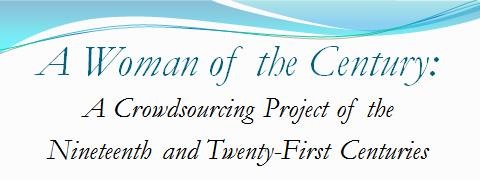A Woman of the Century:
Nineteenth and Twenty-First Century Contributors Project
Who contributed to the creation of A Woman of the Century? What do contributors to A Woman of the Century: A Crowdsourcing Project of the Nineteenth and Twenty-First Century need to know about the book's creation and the process of creating an item record?
By the time they have completed the activities in A Woman of the Century: Nineteenth and Twenty-First Century Contributors Project, people interested in this project will be able to answer both of those questions and many more. A Woman of the Century is a tome, and it would be impossible to create activities related to all aspects of it. However, by selecting representative topics and activities, this project will help students and other contributors engage in historical and critical thinking, and learn about Omeka, as they prepare to become members of the project's Twenty-First Century team.
This project includes eight activities, many of which include primary source resources, a list of women for study and item creation, and examples of item records, for students who will be taking a Women in American History course. The activities may also be of interest to other contributors and all people interested in learning about the book and this site, A Woman of the Century: A Crowdsourcing Project of the Nineteenth and Twenty-First Centuries.
In Teaching History in the Digital Age, Dr. Mills Kelly presents fifteen characteristics of historical thinking. Using specific examples related to A Woman of the Century, the activities in this collection will provide students and contributors with opportunities for practicing several of the types of historical thinking that Dr. Kelly mentions, hopefully providing them with valuable tools for their intellectual toolboxes.
"The History Curriculum in 2023," another of Dr. Kelly's pieces, discusses Making, Mining, Marking, and Mashing, which are four ways that students can learn to engage in historical thinking during this digital age. The activities in this collection will require the students and contributors to participate in all four components. The students and contributors are "making" by interpreting the material and presenting their ideas on blogs and on an Omeka exhibit. This "mining" piece of the project will teach the students about historical databases, about searching with them, about the subjectivity of resources, how to deal with conflicting data, about synthesizing information, about working with Omeka fields, and about creating online bibliographies to assist other researchers. Another part of the project relates to "marking," as it attempts to demystify the need for including detailed metadata in Item Records. In this exercise, students and others will utilize metadata to discover trends about these women. Finally, they will be "mashing" by working with digital maps on their Item Records.
The project culminates with students utilizing the knowledge and material that they have acquired to create a basic Item Record.
At the end of the semester, students will create exhibitions related to the women they are studying. All Twenty-First Century contributors are most welcome to create exhibitions on topics that they find fascinating and important!
Credits
McMaster, MaryKate
